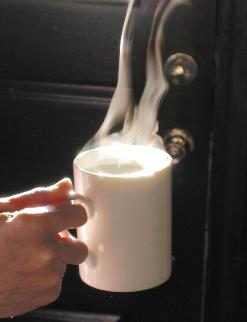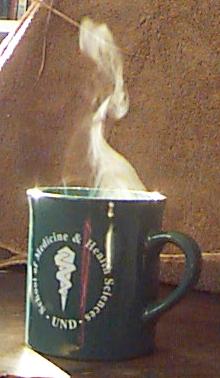
A cup of hot coffee has a plume of steam. This is actually a cloud of tiny drops of water. Why does it happen? Why does the plume disappear as it rises?

| A cup of hot coffee has a plume of steam. This is actually a cloud of tiny drops of water. Why does it happen? Why does the plume disappear as it rises? |
|---|
Water readily evaporates from the hot coffee. The air right above the coffee is warm, and warm air can hold a lot of water. The layer of air right above the liquid may be as much as 20% water! But this layer is lifted by natural convection into the cooler air above it. Now the air cannot hold as much water, and so some returns to the liquid form. Tiny drops condense out, making the visible steam.

| The plume of steam above this cup of coffee is actually a cloud of tiny drops of water. The evaporation of water is an important mechanism for cooling the coffee; the recondensation of the water delivers the energy to the surrounding air. Apparently the air in this room is not as humid as it could be, and so as the steam cloud mixes into the air, the little drops evaporate again. The steam disappears. |
Fog is also little drops of water -- big enough to see, but small enough that they settle very slowly. It occurs when warm, wet air becomes cooled. At night, radiation can cool the air over rivers and lakes and valleys to make foggy mornings.
The upper atmosphere is cold (as discussed previously) . Airplanes produce water vapor when they burn their fuel. The water vapor condenses behind them, making the contrails that we see. The contrails of really high airplanes evaporate quickly, because the stratosphere is dry; the contrails of lower airplanes last a while, because the air is more humid.